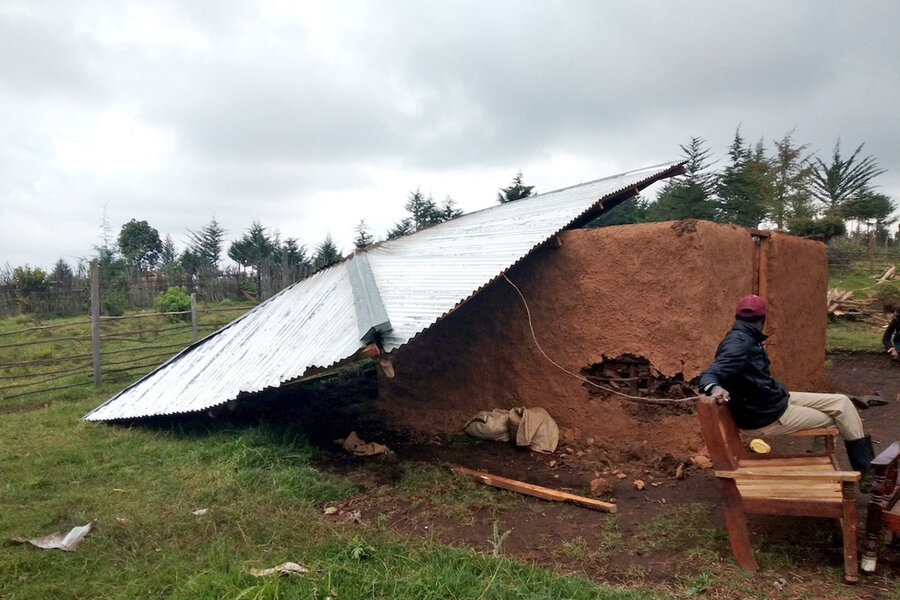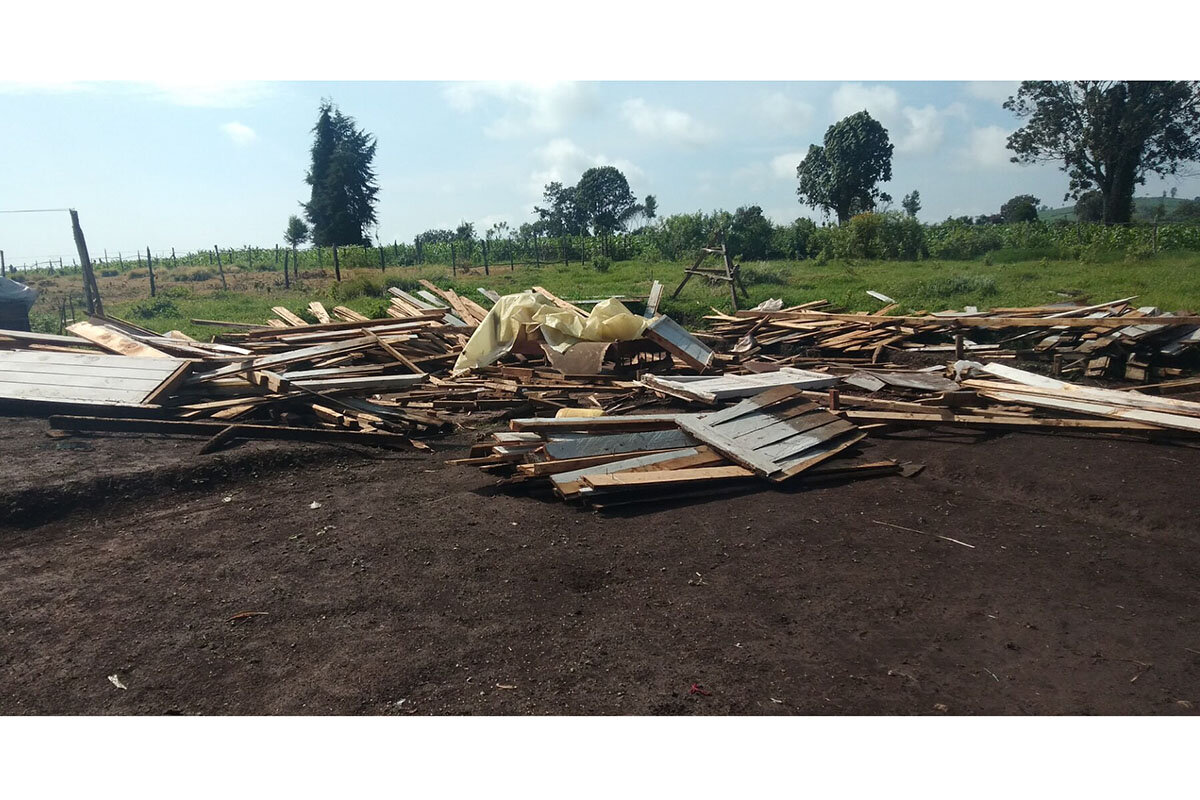Who should care for the forest? In Kenya, the question sparks violence.
Loading...
More than three years after a landmark case recognizing its ancestral home, an Indigenous, forest-dwelling community in Kenya continues to face forced eviction by the government.
Living deep in Kenya’s Mau Forest Complex, the Ogiek people spent 12 years in the Kenyan courts seeking legal redress and acknowledgment of their rights to their homeland. When that proved unfruitful, they turned to the international stage.
After eight more years pursuing justice in the African Court on Human and Peoples’ Rights, in May 2017, that court handed down a ruling recognizing the community’s claim to the Mau Forest Complex.
Why We Wrote This
Amid debates over deforestation, and its causes and solutions, it’s easy to forget one crucial component of forest stewardship: the Indigenous people who often live there.
Despite that landmark ruling, the Ogiek say that they have continued to be driven from their homes. After years of delays, they hope to air their grievances before the court again during its next regular session in Arusha, Tanzania, in late November. At stake is the principle of who can best protect a forest: the government, with all of its resources and expertise, or the people who live there.
“We have now become synonymous with evictions from our ancestral land,” says Daniel Kobei, a Mau-Ogiek community representative, citing recent events in which 300 homes were destroyed by Kenya Forest Service personnel.
“We are now homeless, and have sought shelter among other people, especially in the Marishoni area,” he adds, referencing villages neighboring forest areas where forcible evictions were recently carried out.
From the Kenyan government’s perspective, the evictions are aimed at protecting a vital water resource that has become degraded through human habitation. George Natembeya, an Interior Ministry official who oversees the Mau forest, has denied that the Ogiek are really a forest-dwelling community.
During a community meeting this summer, he accused some members of the Ogiek community of trying to turn a profit on their land, according to Kenya’s Star newspaper. “We know you have sold your own parcels of land and we will soon kick you out to protect water sources,” he said.
Among the trees
The largest native mountain forest in East Africa stretches through Kenya’s Rift Valley, about 100 miles northwest of Nairobi, the country’s capital. Covering an area of more than 1,500 square miles, the Mau Forest Complex is also Kenya’s largest drainage basin and contains the largest of the country’s five water towers.
The Ogiek community says that the forest has been its home for more than a thousand years, and provided its people with wild game, fruit, and medicinal herbs. The Ogiek are also known to practice beekeeping, as honey is a big component of their diet.
But this way of life has severely been eroded, especially with the banning of hunting by the Kenyan government in the late 1970s and early 1980s. Now, the Ogiek have been forced to practice subsistence farming, by growing maize and beans as well as other crops.
The Mau Forest Complex is also the scene of a major environmental disaster. Due to the felling of trees for lumber, charcoal, and farmland, that forest ecosystem has shrunk by nearly 400 square miles since 2000.
Commercial logging has introduced fast-growing cypress and pine trees in place of indigenous ones, which has disrupted honey production. Water, too, has become restricted and contaminated. And members of the community have speculated that a number of bird, insect, animal, and plant species have reduced. Elephants, for example, cannot feed on cypress leaves and have moved elsewhere.
Into the cold
Of the 50,000 estimated total population of the Ogiek, the vast majority inhabit the Mau Forest Complex and are also referred to as the Mau Ogiek.
A smaller community lives on Mount Elgon on the border between Kenya and Uganda. Otherwise, a proportion of its population has since been assimilated into other tribes.
Other Indigenous communities have also allegedly been destroyed by the Kenya Forest Service (KFS) recently. Amnesty International reported that, on July 10, perhaps as many as 28 homes belonging to the Sengwer – another forest-dwelling Indigenous community – were burned to the ground in another major native forest, Embobut Forest.
All this is happening during the coldest season in the country, and the mountainous environment in which families are forced out is already quite chilly. This “is a gross violation of really basic human rights,” says Milka Chepkorir, a member of the Sengwer people and a fellow with Natural Justice, a South African nonprofit that specializes in environmental and human rights law.
And now the evictions are taking place in the middle of the COVID-19 global pandemic, raising health concerns for the displaced communities.
“These recent evictions have affected us really differently this time round,” Ms. Chepkorir says, “because they are taking place in COVID times, when the children are not in school but are playing in the glades.”
Foreign aid or foreign hindrance?
Although evictions are intermittent, there seems to have been a protracted period of relative calm and quiet since 2018, says Ms. Chepkorir.
In January of that year, Robert Kirotich, a Sengwer herdsman was reported to have been gunned down by the KFS guards while tending to his cattle in the forest. This led to the suspension of the European Union-funded Water Towers Protection and Climate Change Mitigation and Adaptation Programme.
That initiative, launched in June 2016, aims to promote the enhancement of ecosystem services while improving livelihoods in Mount Elgon and Cherangany Hills – where two of the five water towers in Kenya sit. (Embobut Forest in Cherangany Hills is where the Sengwer community is allegedly being driven out.)
“Peace has prevailed for the Sengwer in Embobut Forest following the suspension of this funding, until recently,” says Ms. Chepkorir, alluding to the ongoing talks for resuming the EU funding.
Indications that the funding may resume have fueled mistrust from the Indigenous community. The community is doubtful that this financial backing is sufficiently helpful, and attributes its troubles to the availability of donor money.
“You are bound to find displacements in regions where there are foreign funding for conservation purposes in Kenya,” claims Mali ole Kaunga, a representative of Il Lakipiak Maasai community, an Indigenous people found in northern Kenya.
Communities in the Kirisia Forest in northern Kenya, says Mr. Kaunga, have been living peacefully there for centuries, without either the KFS or the Forest Department getting involved. However, trouble erupted when the forest management body began demarcating the approximately 140 square miles of this forest.
Mr. Kaunga alleges that the demarcation is driven by the government’s pledge to raise the forest cover in Kenya from the current 7.2% to about 10% by 2022. This has affected a community of about 5,000 people.
Instead of engaging with the community, the government has elected “a top-down approach,” says Maryama Farah of Natural Justice.
One major hurdle for the Ogiek is the lack of titled deeds for the land. Community spokespeople have long complained that a proliferation of fake deeds has resulted in their land being divided. Last year, the Ogiek called on the Kenyan government to grant a communal deed for land in the Mau forest.
A better way?
But around the world, she says, there are many examples of amicable, environment-friendly resolutions that empower Indigenous communities to become owner-conservators of the land they inhabit.
For example, community-owned forests have been shown to help in expanding natural forest protection in African countries such as Namibia, Gambia, and Tanzania. The same approach is now being employed in Liberia and the Congo.
“Globally, we are moving towards the recognition that community co-management and conservation is the way to go, when it comes to conserving forests for future generations,” Ms. Farah adds.
A growing body of evidence now shows that honoring land rights of rural people in forests is the foundation for conserving forests sustainably. And such community-centered approaches go a long way toward promoting global conservation.
If progress is to be made, says Mr. Kaunga, there needs to be a decoupling of funding from conservation issues. “The community is open to negotiations, but has not been given the opportunity.”






